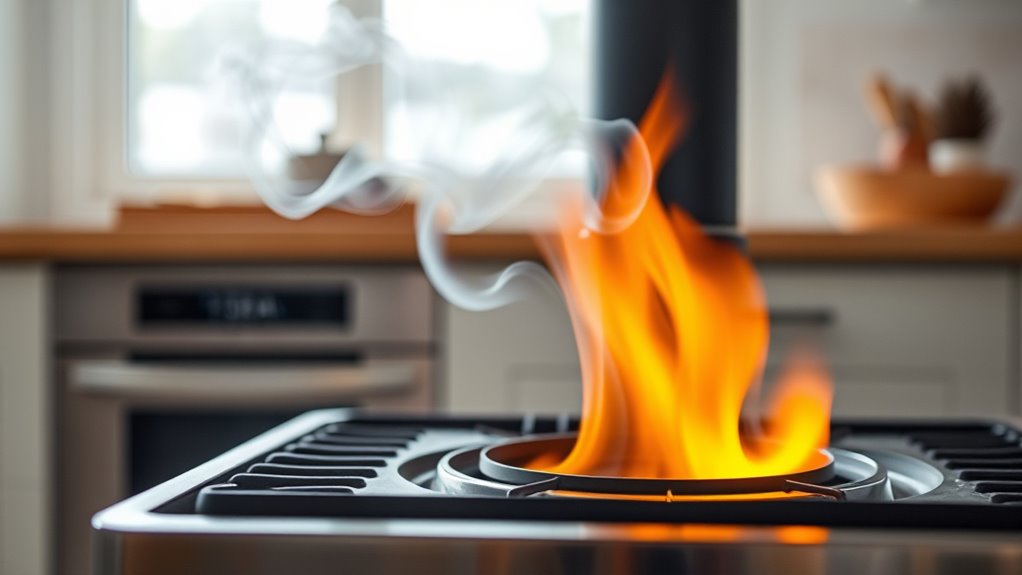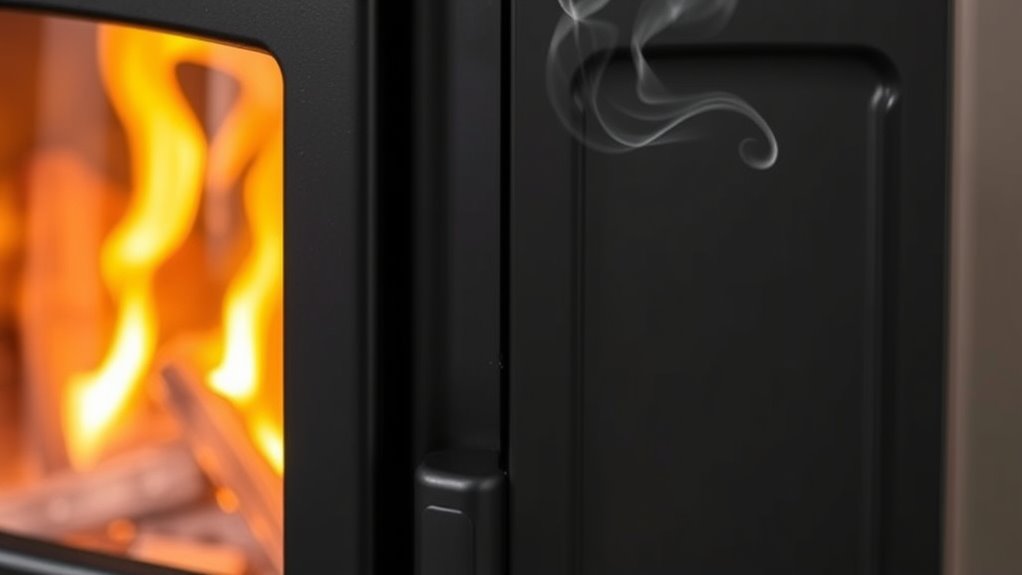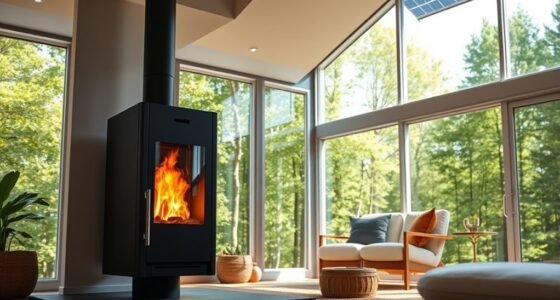EPA-certified stoves reduce particulate emissions by using advanced pollution control technology and strict standards. These stoves burn wood more completely, producing less smoke, ash, and creosote buildup. They are tested to guarantee they meet emission limits, often cutting particulate matter by up to 70%. This means cleaner indoor air and better outdoor air quality. If you want to comprehend how these features actually work, you’ll discover more about their innovative designs and benefits.
Key Takeaways
- EPA-certified stoves incorporate advanced pollution control technology to burn wood more completely, reducing smoke and particulate emissions.
- They meet strict emission limits through rigorous testing, ensuring significantly lower particulate matter release during combustion.
- Improved combustion efficiency minimizes creosote buildup, decreasing particulate emissions and enhancing chimney safety.
- Certified stoves produce less indoor and outdoor air pollution, benefiting respiratory health and environmental quality.
- Their optimized design ensures consistent performance, reliably reducing particulate emissions compared to non-certified models.

If you’re considering a stove upgrade, choosing an EPA-certified model guarantees you’re getting a product that meets strict environmental standards. These stoves are designed to reduce the amount of pollution they produce, especially in terms of particulate emissions from wood burning. Particulate matter, or tiny particles released into the air during combustion, can harm your health and the environment. EPA certification ensures that the stove has been tested and meets specific pollution control standards, making it a smarter choice for eco-conscious homeowners.
When you opt for an EPA-certified stove, you’re investing in advanced pollution control technology that minimizes smoke and particulate emissions. Unlike older wood burning stoves, which often produce thick smoke and high levels of particulate matter, modern EPA models are engineered to burn wood more completely. This means that more of the wood’s energy is converted into heat, and less is wasted as smoke and ash. The result is a cleaner burn that considerably cuts down on the pollutants released into your home and the atmosphere.
EPA certification is based on rigorous testing that measures how efficiently a stove burns wood and how effectively it controls pollution. These tests ensure the stove meets specific emission limits, often reducing particulate emissions by up to 70% compared to non-certified models. As a result, your home experiences less indoor air pollution, which is especially important if you have children, elderly family members, or respiratory concerns. Additionally, cleaner burning stoves produce less creosote buildup in chimneys, lowering the risk of chimney fires and reducing maintenance needs.
Advanced pollution control technology is the key feature that helps EPA-certified stoves achieve these significant emission reductions.
Frequently Asked Questions
How Do Epa-Certified Stoves Compare to Traditional Wood Stoves?
EPA-certified stoves are more efficient and cleaner than traditional wood stoves. They meet strict emissions standards, reducing harmful particulate emissions markedly. You’ll find them fuel-efficient, meaning you use less wood for the same heat output. This not only cuts down your fuel costs but also minimizes your environmental impact. Overall, EPA-certified stoves provide a safer, more sustainable heating option compared to older, traditional models.
What Maintenance Is Required to Keep a Stove Epa-Certified?
To keep your EPA-certified stove performing well, you need to stay on top of burner cleaning and chimney inspection. Regularly clean the burner to prevent buildup, which can reduce efficiency and increase emissions. Don’t forget to examine the chimney for creosote or blockages—neglecting this could compromise air quality and safety. Staying vigilant with these maintenance tasks ensures your stove stays EPA-certified, reducing emissions and keeping your home safer.
Can Epa-Certified Stoves Be Used With All Types of Wood?
You can generally use EPA-certified stoves with most wood types, but stove compatibility varies. Hardwoods like oak and maple burn cleaner and produce less smoke, making them ideal. Softwoods like pine may create more creosote and emissions, possibly affecting stove performance. Always check your stove’s manufacturer guidelines to guarantee compatibility with your chosen wood type. Proper seasoning and avoiding wet or green wood help optimize emissions and stove efficiency.
Are Epa-Certified Stoves Cost-Effective Long-Term Investments?
Like planting a tree that keeps giving, EPA-certified stoves are a smart long-term investment. They offer cost savings through increased efficiency, reducing your fuel bills over time. Plus, you contribute to environmental benefits by lowering particulate emissions, much like a modern-day Robin Hood protecting the air. Though initial costs may be higher, the savings and positive impact make these stoves a wise, eco-friendly choice for years to come.
How Often Do EPA Certifications Need to Be Renewed?
You need to renew your EPA certification every five years. During certification renewal, you’ll submit updated information and guarantee your stove complies with current standards. Stay informed about regulatory updates, as they can affect renewal requirements. Regular renewal helps maintain compliance and ensures your stove continues to meet EPA standards for reducing particulate emissions. Mark your calendar, and check for any changes in regulations to keep your certification current and valid.
Conclusion
By choosing an EPA-certified stove, you’re actively reducing harmful particulate emissions and making your home more environmentally friendly. These stoves meet strict standards, ensuring cleaner air and healthier living conditions. Isn’t protecting the air we breathe worth the investment? With an EPA-certified stove, you take a simple step toward a cleaner, greener future—so why not make the switch today and breathe easier tomorrow?











